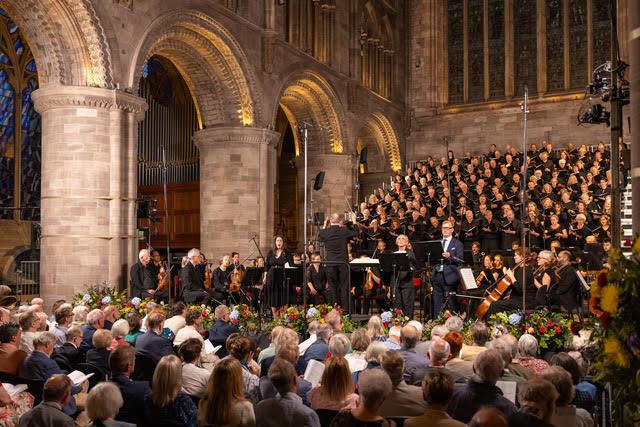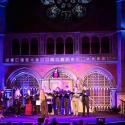“Powerful, Timeless, Inspiring” it says on the front cover of the programme-book for this year’s supposedly 297th Three Choirs Festival at Hereford. So please leave your frivolity at the cathedral door with your gun and your mobile phone.
Richard Blackford has certainly taken the hint with his new cantata, The Black Lake, a studiously tearful, elevated distillation of Caradog Prichard’s One Moonlit Night, a coming-of-age novel about a Welsh boy born and brought up in the slate-quarrying village of Bethesda in north Wales just before and during the First World War. It’s a curious thing about Celtic tales of this kind; life has always been rough, funny, violent, touching, tragic (father nearly always dies in a mining or, as here, quarrying accident). The grown-ups are remote, not very caring, and get up to peculiar things. I’m ashamed to admit that I have not read Prichard’s book, reputedly The Greatest Welsh Novel. But probably its essence, if not its richness of detail and sentiment, can be guessed at from The Black Lake.
The cantata is hybrid, part speech, part music, and herein lies its rather self-evident problem. Blackford uses two actors to tell the story, sometimes in dialogue, sometimes narration. The music, on the other hand, draws out the innate churchiness of the tight-knit Welsh village into an allegory of Christ’s Passion, setting what the composer calls “the highly poetic sections [of the book]… reminiscent of the Song of Songs,” as well as parts of the Anglican Communion liturgy. In themselves these mostly quite brief choruses are impressive, well written in an intense, post-Three-Choirs style, and backed up by a soaring soprano solo for the Queen of the Black Lake, “the grievous waters that lie beyond the utmost sorrow.”
 In terms of the novel, this might make sense; but here one struggles to jump the gap between the gentle emotion of the story and the elegiac grandeur of the music. It’s a little as if Under Milk Wood were to alternate with excerpts from the St. John Passion. David Hill conducted the Festival Chorus and the BBC National Orchestra of Wales in a performance as effective as the work’s anomalies seemed to allow. Betsan Llwyd and Steffan Rhodri spoke the narration beautifully (pictured above left); I would happily have heard twice as much from them. And we did, very willingly, hear twice as much from the soprano, Elizabeth Watts (pictured below right), because she also sang Britten’s Les Illuminations with Hill and the excellent BBC NOW strings in the concert’s first half.
In terms of the novel, this might make sense; but here one struggles to jump the gap between the gentle emotion of the story and the elegiac grandeur of the music. It’s a little as if Under Milk Wood were to alternate with excerpts from the St. John Passion. David Hill conducted the Festival Chorus and the BBC National Orchestra of Wales in a performance as effective as the work’s anomalies seemed to allow. Betsan Llwyd and Steffan Rhodri spoke the narration beautifully (pictured above left); I would happily have heard twice as much from them. And we did, very willingly, hear twice as much from the soprano, Elizabeth Watts (pictured below right), because she also sang Britten’s Les Illuminations with Hill and the excellent BBC NOW strings in the concert’s first half.
This was a brilliant performance, cunningly tailored to the fact that, as always at the Three Choirs, the cheaper seats behind pillars and in the remote cathedral recesses depend on TV screens for a view of the performers. Watts had thought about this and supplemented her singing with an irresistible repertoire of facial expressions that caught to hilarious perfection the outrageous imagery and oxymorons of Rimbaud’s poems and the tonal bravura of Britten’s wonderful settings. Sad for those in the pricier seats that they may have caught less if any of this. But they will have had the greater benefit of Watts’s radiant singing and will have heard more detail of Britten’s vividly inventive scoring than those of us farther back.
 As for Elgar’s Introduction and Allegro, much of its detail, as usual with this kind of intricate orchestration, hid in the 18th century vaults and behind the great Norman columns of the back-to-front nave, platform at the west end. The performance felt energetic and well paced. Arvo Pärt’s Cantus in memoriam Benjamin Britten, which opened the concert, sounds much the same in any acoustic: no more than texture and scales to my ears, no doubt powerful, timeless and inspiring to others.
As for Elgar’s Introduction and Allegro, much of its detail, as usual with this kind of intricate orchestration, hid in the 18th century vaults and behind the great Norman columns of the back-to-front nave, platform at the west end. The performance felt energetic and well paced. Arvo Pärt’s Cantus in memoriam Benjamin Britten, which opened the concert, sounds much the same in any acoustic: no more than texture and scales to my ears, no doubt powerful, timeless and inspiring to others.
Samuel Coleridge-Taylor’s The Atonement, by contrast, is quite at home in these surroundings; in fact it had its premiere in the Three Choirs Festival in this very cathedral in 1903. I seriously doubt whether the performance on that occasion can have been as powerful or assured as this week’s, impressively conducted by Samuel Hudson, Director of Music at Worcester, with a strong team of soloists headed by David Stout (pictured below right) and Mark LeBrocq, the unsinkable Festival Chorus, and the Philharmonia Orchestra, all in terrific fettle.
All of which is to say that this full length oratorio – a retelling of the Passion story to a verse paraphrase of the gospel texts – could hardly have been revived under better auspices. It emerged, nevertheless, as competent and rather dull. Coleridge-Taylor, the London-born son of an English mother and a creole father, suffered down the years from being a one-work master. His early Song of Hiawatha was done to death at the Albert Hall and elsewhere under Malcolm Sargent and others. There was a copy in our piano stool at home which I used to crash through, singing all the parts, to the unconcealed despair of my parents.
 But though corny to some extent, Hiawatha is more interesting and individual than The Atonement. By 1903 Coleridge-Taylor, at 28, was evidently a highly accomplished, highly literate composer, a master orchestrator and a skilful musical thinker over a long span. What he seems to have lacked is an individual response to situation. Most of the music of The Atonement could do just as well for a cantata about the Tower of Babel or, for that matter, Barnaby Rudge. Here and there, his failure to catch the particular moment is almost comical. The Way to Calvary is a non-stop march that mentions, but doesn’t notice, Jesus stumbling; his “It is finished”, the crisis moment of the entire Passion, is introduced by a twiddly flourish on the harp.
But though corny to some extent, Hiawatha is more interesting and individual than The Atonement. By 1903 Coleridge-Taylor, at 28, was evidently a highly accomplished, highly literate composer, a master orchestrator and a skilful musical thinker over a long span. What he seems to have lacked is an individual response to situation. Most of the music of The Atonement could do just as well for a cantata about the Tower of Babel or, for that matter, Barnaby Rudge. Here and there, his failure to catch the particular moment is almost comical. The Way to Calvary is a non-stop march that mentions, but doesn’t notice, Jesus stumbling; his “It is finished”, the crisis moment of the entire Passion, is introduced by a twiddly flourish on the harp.
The work as a whole is better than that, of course. At its best, for instance in the scene with Pilate (and his wife, who gets an aria), it achieves genuine dramatic force, with fine turba-like treatment of the chorus. Coleridge-Taylor could do these things. What he seemingly couldn’t quite do, in this case at least, was make them his.













Add comment